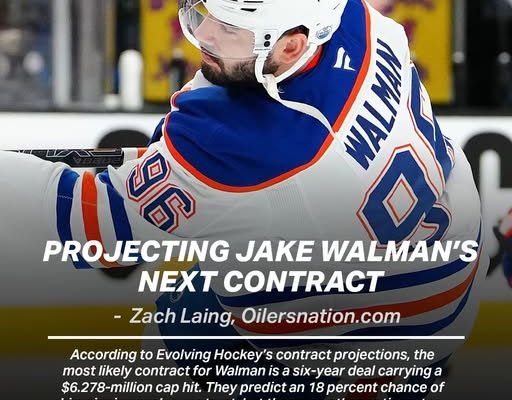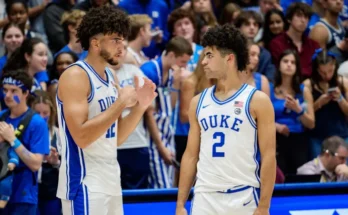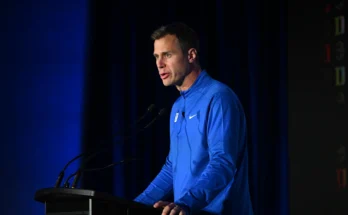**“Crunching the Numbers: Jake Walman Projected for Six-Year, \$6.27M-AAV Deal in Evolving Hockey’s Contract Forecast”**
Jake Walman may not be the first name that comes to mind when you think of the NHL’s top-tier defensemen, but he’s quietly carved out a reputation as one of the league’s most reliable and analytically appreciated blueliners. As the 2025 offseason rolls along and teams prepare to make critical roster decisions, attention has turned to Walman’s impending contract situation. According to projections from Evolving Hockey—a leading outlet in statistical modeling and salary forecasting—the most likely contract for Walman is a six-year deal carrying an average annual value (AAV) of \$6.278 million. The number may raise some eyebrows, but a closer look at Walman’s recent play and potential value on the open market reveals why this projection isn’t just plausible—it’s perhaps even conservative.
Evolving Hockey’s models are built on historical data, player comparisons, age curves, and situational usage. Their algorithms don’t operate on sentiment or perception but on cold, hard numbers that evaluate how a player’s production and underlying impact contribute to winning hockey. When they project a player like Walman to land a six-year deal at just over \$6.27 million per season, it’s because the data backs up his performance at both ends of the ice.
In fact, the analytics crowd has been bullish on Walman for some time now. His ability to suppress shots, control zone entries, and drive play in transition has earned him a solid reputation among coaches and front offices who prioritize defensive reliability and efficient puck movement. He’s also shown offensive growth over the past few seasons, chipping in with goals and assists while anchoring second-pairing minutes and occasionally stepping into top-unit roles when injuries arise. His versatility—combined with his skating ability and hockey IQ—make him an attractive target in a league constantly searching for value contracts on the blue line.
But a six-year commitment isn’t just a reward for past performance—it’s a bet on sustainability. Walman is 29, which means a six-year deal would carry him through age 35. This is typically the point where defensemen begin to experience a performance decline. However, the way Walman plays—relying more on positioning, skating, and stickwork rather than brute physicality—suggests his game might age more gracefully than most. That’s a critical factor when evaluating the long-term viability of a deal approaching \$40 million in total value.
There are other options, of course. Evolving Hockey estimates an 18 percent chance that Walman signs that six-year deal, but there’s also a 17 percent likelihood he opts for either a five-year or three-year extension. The five-year version would carry a projected cap hit of \$6.079 million—slightly lower due to the shorter term—while a three-year pact would come in at \$5.074 million annually. Each of these routes presents a different set of trade-offs. A longer-term deal gives the team cost certainty and the potential for value if the cap continues to rise significantly, as expected. A shorter deal allows Walman to re-enter the market again before his mid-30s, possibly cashing in on another solid contract if his play holds up.
Teams looking to sign Walman will have to weigh these scenarios against their own cap situations, needs, and timelines. For a contending team with a solid core in place and a window to win now, a six-year deal might be palatable, especially if Walman can stabilize a second pairing and log significant minutes on the penalty kill or power play. His ability to play both sides, kill plays in the neutral zone, and drive play forward makes him a luxury few teams can afford to ignore. For teams in transition, a shorter-term commitment might be preferable, providing flexibility while still benefiting from Walman’s leadership and steady hand.
From the player’s perspective, securing long-term financial security will likely be the priority. Walman has never been a superstar in terms of marketability or headline-grabbing stats, so a lengthy, lucrative deal now could be the defining contract of his career. He’s earned that opportunity through years of grinding, improving, and adapting his game to the ever-evolving demands of the NHL.
It’s also worth noting that Walman’s performance over the last two seasons has coincided with a broader evolution in how defensemen are evaluated. Traditional stats like plus-minus and point totals are no longer the gold standard. Instead, expected goals against, zone exit success rates, and shot suppression metrics are now mainstream considerations. By those measures, Walman stacks up favorably against many higher-profile defensemen. His WAR (Wins Above Replacement) numbers consistently place him in the upper echelon of second-pair defenders, and his impact in driving positive outcomes when he’s on the ice has been measurable and repeatable.
That’s not to say the eye test fails him either. Coaches and teammates have consistently praised his calm demeanor under pressure and his willingness to take responsibility in key moments. He’s not flashy, but he’s dependable. He’s not loud, but he leads by example. And in a league where durability and professionalism often go overlooked until they’re gone, Walman has proven to be a valuable constant amid chaos.
There’s also the question of market comparables. In recent years, defensemen with similar profiles—mid-to-late 20s, solid second-pairing usage, positive analytical evaluations—have landed deals in the \$5.5 to \$6.5 million range. Players like Mattias Ekholm, Damon Severson, and Brett Pesce have all set benchmarks for what steady, two-way defensemen can command in free agency. Walman’s projected contract fits neatly within that tier, suggesting that both team executives and analysts see him as a peer to those names.
The projected \$6.278 million AAV isn’t just a reflection of current value—it’s also a bet on future cap growth. With the NHL salary cap set to rise more significantly in the coming years thanks to recovered revenues and new media deals, a contract that might seem steep in 2025 could look like a bargain by 2028. Teams willing to take that long view could find themselves with a key piece at a discount, provided Walman maintains his current level of play.
What complicates the equation is the natural unpredictability of NHL rosters. Injuries, coaching changes, system tweaks, and partner chemistry can all impact a defenseman’s effectiveness. Walman’s ability to adapt will be crucial in justifying whichever deal he eventually signs. But based on what we’ve seen so far, there’s every reason to believe he’ll continue to thrive in whatever role he’s given.
Of course, the final decision will depend on more than just numbers and projections. There are personal considerations—lifestyle, family, career goals—that may influence Walman’s preferred destination. And there’s the matter of team fit: which franchises see him as the missing piece, and which ones can afford to pay him without compromising other parts of their roster?
In today’s NHL, roster construction is a game of chess, not checkers. Every move carries ripple effects, and signing a defenseman to a multi-year deal at over \$6 million per season is a serious commitment. But when that player brings consistency, adaptability, and elite underlying numbers, it becomes a calculated risk rather than a blind leap. Jake Walman’s situation exemplifies this balance perfectly.
As the offseason rolls on and teams begin to make moves, all eyes will be on whether the projection from Evolving Hockey comes to fruition. Will Walman land the full six-year, \$6.278 million deal? Will a team opt for a shorter term at a reduced AAV? Or will a surprise suitor step in and offer something entirely different? Regardless of the outcome, one thing is clear: Jake Walman has earned his spot in the conversation, and his next contract could very well define the next chapter of both his career and the team lucky enough to sign him.
There’s something fitting about Walman’s rise happening quietly, away from the spotlight, in much the same way he plays the game. No fanfare, no drama—just steady improvement, consistent effort, and results that speak for themselves. In a league increasingly driven by data, Jake Walman is the kind of player every team says they want. The question now is who’s ready to pay for it—and how much they’re willing to invest in a defenseman whose game is built on the very principles modern hockey values most.



